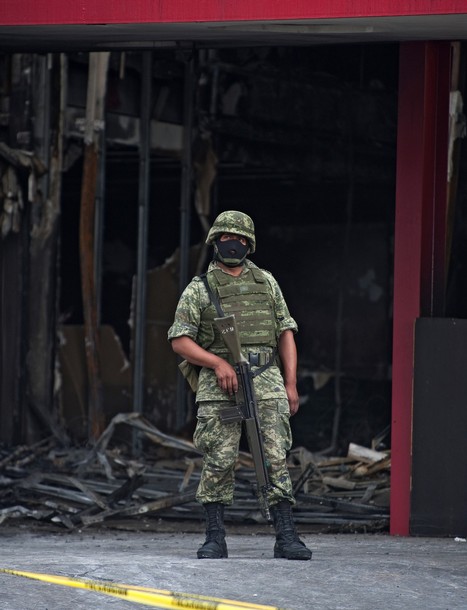
A member of the Mexican Army stands guard in front of the rubble of the Casino Royale, in Monterrey, Mexico, on August 26, 2011. Calderon condemned Friday the "abhorrent and barbaric" killing of 52 people by suspected drug cartel gunmen who ruthlessly set a casino ablaze. The particularly callous attack on Thursday evening shocked a nation routinely used to grim murders and high tolls in a drugs war that has claimed more than 41,000 lives since Calderon launched a military crackdown in 2006. AFP PHOTO/RONALDO SCHEMIDT
US-Trained Assassin Teams Now Deployed in Drug War (Narco News):
A small but growing proxy war is underway in Mexico pitting US-assisted assassin teams composed of elite Mexican special operations soldiers against the leadership of an emerging cadre of independent drug organizations that are far more ruthless than the old-guard Mexican “cartels” that gave birth to them.
These Mexican assassin teams now in the field for at least half a year, sources tell Narco News, are supported by a sophisticated US intelligence network composed of CIA and civilian US military operatives as well as covert special-forces soldiers under Pentagon command — which are helping to identify targets for the Mexican hit teams.
Evidence of this intelligence support network has surfaced recently even in mainstream media reports, in outlets such as the New York Times and the Mexican publication El Universal — the former reporting that “CIA operatives and American civilian military employees have been posted at a Mexican military base,” and the latter reporting that elite US and Mexican troops engaged in joint training exercises in Colorado earlier this year.
But Narco News as far back as June of 2010 reported that a special forces US task force had “boots on the ground” in Mexico assisting the Mexican military in tracking down the top capos of Mexico’s major drug “cartels” – such as the Juarez, Beltran Leyva, Zetas and La Familia organizations. (The Sinaloa organization’s top leadership, however, has been left largely untouched, and by design if you believe the recent US court pleadings of Vicente Zambada Niebla, a Sinaloa leader now imprisoned in Chicago who claims a quid pro quo deal has been struck between the Sinaloa drug syndicate and the US government.) [See link].
Narco News also reported in April of this year that a unit of a major US defense contractor was advertising in the mercenary community for “site leads” who can help oversee the company’s personnel in Mexico and also coordinate “with Mexican Army officials” at a dozen training sites, called “VMTCs [Virtual Military Training Centers],” located in Mexico.
The information in the job posting described the US military contractor’s training network in Mexico as being part of an effort called “Project Sparta,” which is designed “to train Mexican Army soldiers in basic and advanced urban warfare operations” with the ultimate goal of creating an “Urban Warfare Elite Force.”
The “new specialized reaction force” will support “federal, state and local law enforcement agencies in the war against organized crime and the drug cartels,” the help-wanted ad stated.
Now, an official with the company posting the want ad, L-3 MPRI, claimed that “we don’t have a contract [in Mexico] to do that kind of work.” The ad was subsequently removed from the company’s Web site.
Regardless, the fact that the ad was posted at all on the L-3 MPRI Web site seems to indicate that someone in Mexico was seeking the “urban warfare” training services, even if L-3 MPRI did not get the contract.
…
According to Plumlee, members of the same US special-forces task force that assisted in the takedown of Beltran Leyva are now providing intelligence support and ongoing training to the Mexican assassin teams set up to target the leaders of the proliferating narco splinter groups.
The mission of these specialized Mexican attack units, Plumlee contends, is to “neutralize” (kill) the targets. This is a new focus, since before the Mexican military was targeting the leadership of the major drug organizations for capture, if possible. But in this case, capture is not the goal, and the targets are the leaders of these hyper-violent, independent splinter groups that have sprung up in the wake of the shakeup, via capture or killing, in the leadership of the major cartels — with the Sinaloa organization, it seems, being protected from a fatal attack on its leadership.
Plumlee contends that the old-guard “cartels” also see these splinter groups as their enemies, given they are rivals threatening the stability of the existing business model, so in essence the Mexican assassin teams are also serving the interests of the dominate narco groups the drug war is suppose to be combating.
“Some of the intelligence on the splinter groups is actually being provided by members of the Zetas,” Plumlee claims.
There are supposedly at least three such Mexican hit teams operating now in Mexico (in the north, central and southern regions of the country).